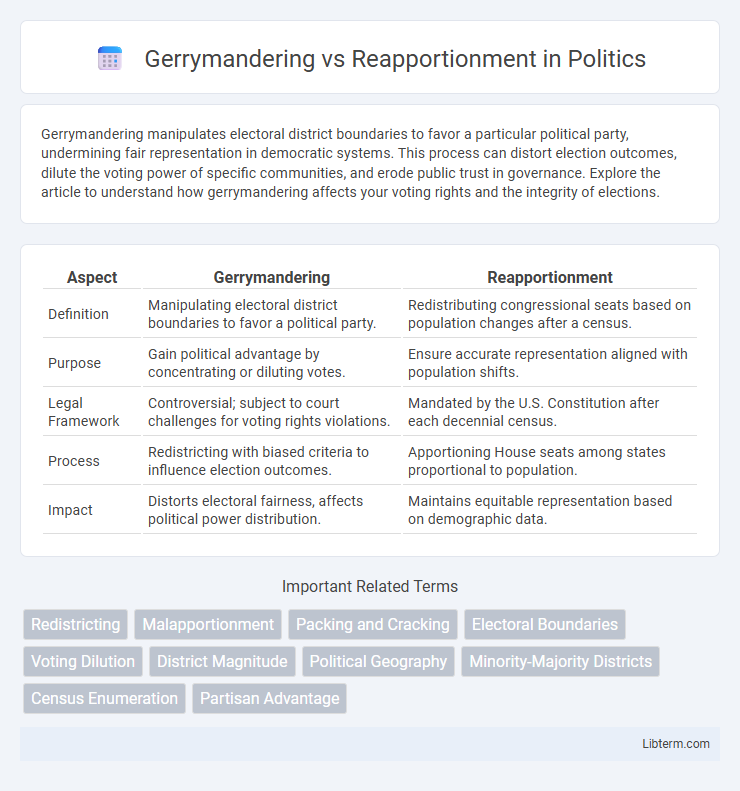Gerrymandering manipulates electoral district boundaries to favor a particular political party, undermining fair representation in democratic systems. This process can distort election outcomes, dilute the voting power of specific communities, and erode public trust in governance. Explore the article to understand how gerrymandering affects your voting rights and the integrity of elections.
Table of Comparison
| Aspect | Gerrymandering | Reapportionment |
|---|---|---|
| Definition | Manipulating electoral district boundaries to favor a political party. | Redistributing congressional seats based on population changes after a census. |
| Purpose | Gain political advantage by concentrating or diluting votes. | Ensure accurate representation aligned with population shifts. |
| Legal Framework | Controversial; subject to court challenges for voting rights violations. | Mandated by the U.S. Constitution after each decennial census. |
| Process | Redistricting with biased criteria to influence election outcomes. | Apportioning House seats among states proportional to population. |
| Impact | Distorts electoral fairness, affects political power distribution. | Maintains equitable representation based on demographic data. |
Introduction to Gerrymandering and Reapportionment
Gerrymandering refers to the deliberate manipulation of electoral district boundaries to favor a particular political party or group, often resulting in distorted representation. Reapportionment is the process of redistributing legislative seats based on population changes determined by the decennial census, ensuring equal representation across districts. While reapportionment aims to reflect demographic shifts fairly, gerrymandering exploits the redistricting process to entrench political power.
Defining Gerrymandering
Gerrymandering is the manipulation of electoral district boundaries to favor a particular political party or group, often resulting in oddly shaped districts designed to dilute the voting power of opponents. This practice undermines fair representation by concentrating or dispersing voters strategically to influence election outcomes. In contrast, reapportionment refers to the regular redistribution of legislative seats based on population changes, conducted without political bias to ensure equal representation.
Explaining Reapportionment
Reapportionment refers to the process of redistributing seats in a legislative body based on population changes determined by the decennial census. It ensures equitable representation by adjusting the number of districts each state holds in the House of Representatives according to shifts in population density and demographics. This process differs from gerrymandering, which manipulates district boundaries for political advantage rather than population fairness.
Historical Origins and Development
Gerrymandering originated in the early 19th century, named after Massachusetts Governor Elbridge Gerry, who manipulated district boundaries to favor his party in 1812. Reapportionment has roots in the Constitutional mandate to reallocate congressional seats based on decennial census data, established to ensure equal representation as populations shift. Over time, gerrymandering evolved into a controversial political strategy, while reapportionment developed as a necessary, rule-based process to maintain balanced legislative representation.
Key Differences Between Gerrymandering and Reapportionment
Gerrymandering involves manipulating electoral district boundaries to favor a particular political party or group, often resulting in oddly shaped districts designed to maximize electoral advantage. Reapportionment, on the other hand, is the process of redistributing legislative seats based on population changes identified by the decennial census, ensuring equal representation according to population shifts. While reapportionment deals with the fair allocation of representatives, gerrymandering specifically alters district lines to influence election outcomes.
Legal and Constitutional Frameworks
Gerrymandering involves manipulating electoral district boundaries to favor a particular political party or group, often challenged under the Equal Protection Clause of the 14th Amendment. Reapportionment is the constitutional process of reallocating congressional seats based on population changes identified in the decennial census, mandated by Article I, Section 2 of the U.S. Constitution. Legal frameworks surrounding these practices include landmark Supreme Court cases such as Baker v. Carr, which established the justiciability of redistricting disputes, and Reynolds v. Sims, which reinforced the principle of "one person, one vote.
Impacts on Electoral Representation
Gerrymandering distorts electoral representation by manipulating district boundaries to favor a political party, undermining the principle of voter equality and often marginalizing minority groups. Reapportionment, based on population changes from the census, aims to adjust the allocation of legislative seats proportionally, promoting fair representation across regions. The contrast lies in gerrymandering's potential to skew political power and reduce competitiveness, whereas reapportionment seeks to reflect demographic shifts and maintain balanced voter influence.
Notable Cases and Controversies
Notable cases in gerrymandering include *Rucho v. Common Cause* (2019), where the Supreme Court ruled that partisan gerrymandering claims present political questions beyond federal courts' reach, and *Shelby County v. Holder* (2013), which weakened key Voting Rights Act provisions, impacting redistricting oversight. Reapportionment controversies often emerge after the decennial census, as seen in the 2010 U.S. Census-driven redistricting, which led to lawsuits over racial and partisan biases in states like North Carolina and Texas. Legal battles frequently center on whether district boundaries dilute minority voting power or unfairly advantage political parties, highlighting ongoing tensions between democratic representation and political strategy.
Reform Efforts and Policy Solutions
Reform efforts targeting gerrymandering versus reapportionment emphasize the implementation of independent redistricting commissions to ensure impartial boundary delineation and enhance electoral fairness. Policy solutions also include the adoption of algorithmic or computer-generated district maps based on objective criteria such as compactness and political competitiveness to minimize partisan bias. Legislative measures promoting transparency, public input, and clear redistricting standards further aim to reduce manipulation and bolster democratic representation.
Conclusion: Shaping Fair Political Districts
Gerrymandering manipulates district boundaries to favor specific political parties, undermining fair representation, while reapportionment ensures equitable distribution based on population changes following the census. Effective reapportionment promotes balanced political power and reflects demographic shifts, contrasting with gerrymandering's distortion of electoral fairness. Transparent, impartial redistricting processes are essential to uphold democratic principles and create politically competitive districts.
Gerrymandering Infographic

 libterm.com
libterm.com